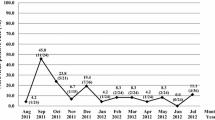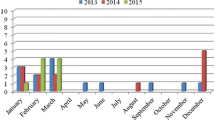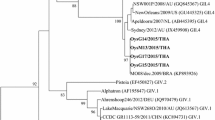Abstract
In recent years, annual cases of gastroenteritis have been reported in the world at high rates, suggesting an association with the consumption of shellfish with enteric viruses in their tissues. Anthropic activities are considered a source of environmental pollution and the main responsible for contamination by pathogenic microorganisms in aquatic environments. The objective of this study was to evaluate, by RT-semi-nested PCR, the presence of astrovirus (AstV) and norovirus genogroup II (NoV GII) in mussels (Mytella falcata) and oysters (Crassostrea brasiliana) collected in two sites of the Lagunar Complex of Cananéia, State of São Paulo, Brazil. A total of 150 samples of mussels and oysters (75 samples each) were analyzed. AstV was not identified in any shellfish sample. NoV GII was detected in 21 samples (14%), 8 mussel samples (38%), and 13 oyster samples (62%). From the 21 positive samples, 16 were analyzed by nucleotide sequencing. The molecular characterization revealed that Brazilian samples were grouped into clades along with other sequences from Brazil, Japan, and Mexico. There was 93.8–100% amino acid sequence similarity among the samples in this study and > 94.9% when compared with the strains isolated from clinical cases in Brazil. The screening of shellfish for the presence of health-significant enteric viruses can help prevent outbreaks among consumers and contribute to the improvement of the estuarine environment.


Similar content being viewed by others
References
Di Renzo L, Colica C, Carraro A, Cenci Goga B, Marsella LT, Botta R et al (2015) Food safety and nutritional quality for the prevention of non communicable diseases: the Nutrient, hazard Analysis and Critical Control Point process (NACCP). J Transl Med 13:1–13. https://doi.org/10.1186/s12967-015-0484-2
Leal Diego AG, Dores Ramos AP, Marques Souza DS, Durigan M, Greinert-Goulart JA, Moresco V et al (2013) Sanitary quality of edible bivalve mollusks in Southeastern Brazil using an UV based depuration system. Ocean Coast Manag 72:93–100. https://doi.org/10.1016/j.ocecoaman.2011.07.010
da Rocha MP, Dourado PLR, Cardoso CAL, Cândido LS, Pereira JG, de Oliveira KMP et al (2018) Tools for monitoring aquatic environments to identify anthropic effects. Environ Monit Assess 190:1–13
Ballesteros ML, Rivetti NG, Morillo DO, Bertrand L, Amé MV, Bistoni MA (2017) Multi-biomarker responses in fish (Jenynsia multidentata) to assess the impact of pollution in rivers with mixtures of environmental contaminants. Sci Total Environ 595:711–722
Souza DSM, Dominot AFÁ, Moresco V, Barardi CRM (2018) Presence of enteric viruses, bioaccumulation and stability in Anomalocardia brasiliana clams (Gmelin, 1791). Int J Food Microbiol 266:363–371. https://doi.org/10.1016/j.ijfoodmicro.2017.08.004
El Nemr A, El-Said GF, Ragab S, Khaled A, El-Sikaily A (2016) The distribution, contamination and risk assessment of heavy metals in sediment and shellfish from the Red Sea coast. Egypt Chemosphere 165:369–380. https://doi.org/10.1016/j.chemosphere.2016.09.048
Marques JA, Silva de Assis HC, Guiloski IC, Sandrini-Neto L, Carreira RS, Lana PC, Antioxidant defense responses in Mytella guyanensis (Lamarck, (1819) exposed to an experimental diesel oil spill in Paranaguá Bay (Paraná, Brazil). Ecotoxicol Environ Saf 2014(107):269–275. https://doi.org/10.1016/j.ecoenv.2014.06.001
Carter MJ (2005) Enterically infecting viruses: pathogenicity, transmission and significance for food and waterborne infection. J Appl Microbiol 98:1354–1380. https://doi.org/10.1111/j.1365-2672.2005.02635.x
Walker DI, Younger A, Stockley L, Baker-Austin C (2018) Escherichia coli testing and enumeration in live bivalve shellfish – present methods and future directions. Food Microbiol 73:29–38. https://doi.org/10.1016/j.fm.2017.12.006
Cormier J, Gutierrez M, Goodridge L, Janes M (2014) Concentration of enteric virus indicator from seawater using granular activated carbon. J Virol Methods 196:212–218
FAO. FAO 2008.
Torok V, Hodgson K, McLeod C, Tan J, Malhi N, Turnbull A (2018) National survey of foodborne viruses in Australian oysters at production. Food Microbiol 69:196–203. https://doi.org/10.1016/j.fm.2017.08.014
Campos CJA, Kershaw S, Morgan OC, Lees DN (2017) Risk factors for norovirus contamination of shellfish water catchments in England and Wales. Int J Food Microbiol 241:318–324. https://doi.org/10.1016/j.ijfoodmicro.2016.10.028
Mesquita JR, Vaz L, Cerqueira S, Castilho F, Santos R, Monteiro S et al (2011) Norovirus, hepatitis A virus and enterovirus presence in shellfish from high quality harvesting areas in Portugal. Food Microbiol 28:936–941. https://doi.org/10.1016/j.fm.2011.01.005
Bellou M, Kokkinos P, Vantarakis A (2013) Shellfish-borne viral outbreaks: a systematic review. Food Environ Virol 5:13–23. https://doi.org/10.1007/s12560-012-9097-6
Hodgson KR, Torok VA, Turnbull AR (2017) Bacteriophages as enteric viral indicators in bivalve mollusc management. Food Microbiol 65:284–293. https://doi.org/10.1016/j.fm.2017.03.003
Padovan AC, Neave MJ, Munksgaard NC, Gibb KS. Multiple approaches to assess the safety of artisanal marine food in a tropical estuary. Environ Monit Assess 2017;189. https://doi.org/10.1007/s10661-017-5842-5.
La Rosa G, Fratini M, Vennarucci VS, Guercio A, Purpari G, Muscillo M (2012) GIV noroviruses and other enteric viruses in bivalves: a preliminary study. New Microbiol 35:27–34
Le Guyader F, Neill FH, Estes MK, Monroe SS, Ando T, Atmar RL (1996) Detection and analysis of a small round-structured virus strain in oysters implicated in an outbreak of acute gastroenteritis. Appl Environ Microbiol 62:4268–4272. https://doi.org/10.1128/aem.62.11.4268-4272.1996
Le Guyader FS, Neill FH, Dubois E, Bon F, Loisy F, Kohli E et al (2003) A semiquantitative approach to estimate Norwalk-like virus contamination of oysters implicated in an outbreak. Int J Food Microbiol 87:107–112. https://doi.org/10.1016/S0168-1605(03)00058-8
Ng TL, Chan PP, Phua TH, Loh JP, Yip R, Wong C et al (2005) Oyster-associated outbreaks of norovirus gastroenteritis in Singapore. J Infect 51:413–418. https://doi.org/10.1016/j.jinf.2004.11.003
Le Guyader FS, Krol J, Ambert-Balay K, Ruvoen-Clouet N, Desaubliaux B, Parnaudeau S et al (2010) Comprehensive analysis of a norovirus-associated gastroenteritis outbreak, from the environment to the consumer. J Clin Microbiol 48:915–920. https://doi.org/10.1128/JCM.01664-09
Lunestad BT, Maage A, Roiha IS, Myrmel M, Svanevik CS, Duinker A (2016) An outbreak of norovirus infection from shellfish soup due to unforeseen insufficient heating during preparation. Food Environ Virol 8:231–234. https://doi.org/10.1007/s12560-016-9245-5
Iritani N, Kaida A, Abe N, Kubo H, Sekiguchi J, Yamamoto SP et al (2014) Detection and genetic characterization of human enteric viruses in oyster-associated gastroenteritis outbreaks between 2001 and 2012 in Osaka City. Japan J Med Virol 86:2019–2025
Le Guyader F, Haugarreau L, Miossec L, Dubois E, Pommepuy M (2000) Three-year study to assess human enteric viruses in shellfish. Appl Environ Microbiol 66:3241–3248. https://doi.org/10.1128/AEM.66.8.3241-3248.2000
Ming HX, Fan JF, Wu LJ, Liang YB (2013) Prevalence of human enteric viruses and a potential indicator of contamination in shellfish in China. J Food Saf 33:209–214. https://doi.org/10.1111/jfs.12041
de Farias MF, de Almeida R-B, de Carvalho FCT, Silva CM, dos Reis EMF, Costa RA et al (2010) Condições Microbiológicas De Tagelus Plebeius (Lightfoot, 1786) (Mollusca: Bivalvia: Solecurtidae) E Da Água No Estuário Do Rio Ceará, Em Fortaleza - CE. Bol Do Inst Pesca 36:135–142
Ramos RJ, Pereira MA, Miotto LA, de Faria LFB, Silveira Junior N, Vieira CRW (2010) Microrganismos indicadores de qualidade higiênico-sanitária em ostras (Crassostrea gigas) e águas salinas de fazendas marinhas localizadas na Baía Sul da Ilha de Santa Catarina. Brasil Rev Do Inst Adolfo Lutz 69:29–37
Sande D, Melo TA, Oliveira GSA, Barreto L, Talbot T, Boehs G et al (2010) Prospecção de moluscos bivalves no estudo da poluição dos rios Cachoeira e Santana em Ilhéus, Bahia, Brasil. Brazilian J Vet Res Anim Sci 47:190–196
da Silveira MA, Leão MVP, dos Santos SSF, Jorge AOC, Gonçalves CR, Qualidade sanitária da água e de bivalves Iphigenia brasiliensis (Lamarck, (1818) na praia do Jabaquara, Paraty. RJ Rev Biociências 2011:17
Barbieri E, Bondioli AC, Woiciechovski E, Zapotoski SMK (2012) Microbiology quality of the oysters cultivation water marketed in Cananeia-SP. Brazil O Mundo Da Saúde 36:541–547
Doi SA, de Cardoso Oliveira AJF, Barbieri E (2015) Determinação de coliformes na água e no tecido mole das ostras extraídas em Cananéia, São Paulo. Brasil Eng Sanit e Ambient 20:111–118. https://doi.org/10.1590/S1413-41522015020000125658
Sincero TCM, Levin DB, Simões CMO, Barardi CRM (2006) Detection of hepatitis A virus (HAV) in oysters (Crassostrea gigas). Water Res 40:895–902
Rigotto C, Victoria M, Moresco V, Kolesnikovas CK, Corrêa AA, Souza DSM et al (2010) Assessment of adenovirus, hepatitis A virus and rotavirus presence in environmental samples in Florianopolis. South Brazil J Appl Microbiol 109:1979–1987
Keller R, Justino JF, Cassini ST (2013) Assessment of water and seafood microbiology quality in a mangrove region in Vitória. Brazil J Water Health 11:573–580
Leal DAG, Souza DSM, Caumo KS, Fongaro G, Panatieri LF, Durigan M et al (2018) Genotypic characterization and assessment of infectivity of human waterborne pathogens recovered from oysters and estuarine waters in Brazil. Water Res 137:273–280
Brake F, Ross T, Holds G, Kiermeier A, McLeod C (2014) A survey of Australian oysters for the presence of human noroviruses. Food Microbiol 44:264–270. https://doi.org/10.1016/j.fm.2014.06.012
da Silva Luz I, Miagostovich MP. Norovírus em alimentos. Vigilância Sanitária Em Debate Soc Ciência Tecnol (Health Surveill under Debate Soc Sci Technol Em Debate 2017;5:100–15.
Lodder-Verschoor F, de Roda Husman AM, Van Den Berg H, Stein A, van Pelt-Heerschap HML, Van der Poel WHM (2005) Year-round screening of noncommercial and commercial oysters for the presence of human pathogenic viruses. J Food Prot 68:1853–1859
FDA. FDA 2007.
ISO. ISO 15216–1, 2017. n.d.
Barbier EB, Hacker SD, Kennedy C, Koch EW, Stier AC, Silliman BR (2011) The value of estuarine and coastal ecosystem services. Ecol Monogr 81:169–193
del Favero JM, Dias JF (2015) Juvenile fish use of the shallow zone of beaches of the Cananéia-Iguape coastal system, southeastern Brazil. Brazilian J Oceanogr 63:103–114
De Oliveira FC, Hanazaki N (2011) Ethnobotany and ecological perspectives on the management and use of plant species for a traditional fishing trap, southern coast of São Paulo. Brazil J Environ Manage 92:1783–1792. https://doi.org/10.1016/j.jenvman.2011.02.002
Tse H, Chan W-M, Tsoi H-W, Fan RYY, Lau CCY, Lau SKP et al (2011) Rediscovery and genomic characterization of bovine astroviruses. J Gen Virol 92:1888–1898
Terio V, Martella V, Moschidou P, Di Pinto P, Tantillo G, Buonavoglia C (2010) Norovirus in retail shellfish. Food Microbiol 27:29–32. https://doi.org/10.1016/j.fm.2009.07.005
Yuen LKW, Catton MG, Cox BJ, Wright PJ, Marshall JA (2001) Heminested multiplex reverse transcription-PCR for detection and differentiation of Norwalk-like virus genogroups 1 and 2 in fecal samples. J Clin Microbiol 39:2690–2694. https://doi.org/10.1128/JCM.39.7.2690-2694.2001
Altschul SF, Madden TL, Schäffer AA, Zhang J, Zhang Z, Miller W et al (1997) Gapped BLAST and PSI-BLAST: a new generation of protein database search programs. Nucleic Acids Res 25:3389–3402
Thompson JD, Higgins DG, Gibson TJ (1994) CLUSTAL W: improving the sensitivity of progressive multiple sequence alignment through sequence weighting, position-specific gap penalties and weight matrix choice. Nucleic Acids Res 22:4673–4680
Hall TA. BioEdit: a user-friendly biological sequence alignment editor and analysis program for Windows 95/98/NT. Nucleic Acids Symp. Ser., vol. 41, [London]: Information Retrieval Ltd., c1979-c2000.; 1999, p. 95–8.
Campanella JJ, Bitincka L, Smalley J (2003) MatGAT: an application that generates similarity/identity matrices using protein or DNA sequences. BMC Bioinformatics 4:1–4
Tamura K, Stecher G, Peterson D, Filipski A, Kumar S. MEGA6: molecular evolutionary genetics analysis version 6.0. Mol Biol Evol 2013;30:2725–9.
Yamashita T, Kobayashi S, Sakae K, Nakata S, Chiba S, Ishihara Y et al (1991) Isolation of cytopathic small round viruses with BS-C-1 cells from patients with gastroenteritis. J Infect Dis 164:954–957. https://doi.org/10.1093/infdis/164.5.954
Elamri DE, Aouni M, Parnaudeau S, Le Guyader FS (2006) Detection of human enteric viruses in shellfish collected in Tunisia. Lett Appl Microbiol 43:399–404. https://doi.org/10.1111/j.1472-765X.2006.01978.x
Gabrieli R, Macaluso A, Lanni L, Saccares S, Di Giamberardino F, Cencioni B et al (2007) Enteric viruses in molluscan shellfish. New Microbiol 30:471–475
Le Guyader FS, Le Saux JC, Ambert-Balay K, Krol J, Serais O, Parnaudeau S et al (2008) Aichi virus, norovirus, astrovirus, enterovirus, and rotavirus involved in clinical cases from a French oyster-related gastroenteritis outbreak. J Clin Microbiol 46:4011–4017. https://doi.org/10.1128/JCM.01044-08
Miagostovich MP, Ferreira FFM, Guimarães FR, Fumian TM, Diniz-Mendes L, Luz SLB et al (2008) Molecular detection and characterization of gastroenteritis viruses occurring naturally in the stream waters of Manaus, central Amazonia. Brazil Appl Environ Microbiol 74:375–382
Fumian TM, Vieira CB, Leite JPG, Miagostovich MP (2013) Assessment of burden of virus agents in an urban sewage treatment plant in Rio de Janeiro. Brazil J Water Health 11:110–119
Nuñez LFN, Parra SHS, Carranza C, Astolfi-Ferreira CS, Buim MR, Ferreira AJP (2016) Detection and molecular characterization of chicken astrovirus associated with chicks that have an unusual condition known as “white chicks” in Brazil. Poult Sci 95:1262–1270
Siqueira JAM, de Souza OD, de Carvalho TCN, Portal TM, Justino MCA, da Silva LD et al (2017) Astrovirus infection in hospitalized children: molecular, clinical and epidemiological features. J Clin Virol 94:79–85
Alves CDBT, Budaszewski RF, Torikachvili M, Streck AF, Weber MN, Cibulski SP et al (2018) Detection and genetic characterization of Mamastrovirus 5 from Brazilian dogs. Brazilian J Microbiol 49:575–583
Gularte JS, Girardi V, Demoliner M, de Souza FG, Filippi M, Eisen AKA et al (2019) Human mastadenovirus in water, sediment, sea surface microlayer, and bivalve mollusk from southern Brazilian beaches. Mar Pollut Bull 142:335–349
Gentry J, Vinjé J, Guadagnoli D, Lipp EK (2009) Norovirus distribution within an estuarine environment. Appl Environ Microbiol 75:5474–5480. https://doi.org/10.1128/AEM.00111-09
Boxman ILA, Tilburg JJHC, te Loeke NAJM, Vennema H, Jonker K, de Boer E et al (2006) Detection of noroviruses in shellfish in the Netherlands. Int J Food Microbiol 108:391–396. https://doi.org/10.1016/j.ijfoodmicro.2006.01.002
Croci L, Losio MN, Suffredini E, Pavoni E, Di Pasquale S, Fallacara F et al (2007) Assessment of human enteric viruses in shellfish from the northern Adriatic sea. Int J Food Microbiol 114:252–257. https://doi.org/10.1016/j.ijfoodmicro.2006.09.015
Lees D (2000) Viruses and bivalve shellfish. Int J Food Microbiol 59:81–116. https://doi.org/10.1016/S0168-1605(00)00248-8
Atmar RL (2010) Noroviruses: state of the art. Food Environ Virol 2:117–126
Le Saux JC, Serais O, Krol J, Parnaudeau S, Salvagnac P, Delmas G, et al. Evidence of the presence of viral contamination in shellfish after short rainfall events. J Shellfish Res Open Access Version Http//Archier Ifremer Fr/Doc/00066/17736 2009.
Bigoraj E, Kwit E, Chrobocińska M, Rzeżutka A (2014) Occurrence of norovirus and hepatitis A virus in wild mussels collected from the Baltic Sea. Food Environ Virol 6:207–212. https://doi.org/10.1007/s12560-014-9153-5
Moresco V, Viancelli A, Nascimento MA, Souza DSM, Ramos APD, Garcia LAT et al (2012) Microbiological and physicochemical analysis of the coastal waters of Southern Brazil. Mar Pollut Bull 64:40–48
Ferro de Godoy D, Andriolo A, de Fatima Filla G. The influence of environmental variables on estuarine dolphins (Sotalia guianensis) spatial distribution and habitat used in the Estuarine Lagunar Complex of Cananéia, southeastern Brazil. Ocean Coast Manag 2015;106:68–76. https://doi.org/10.1016/j.ocecoaman.2015.01.013.
Keller R, Pratte-Santos R, Scarpati K, Martins SA, Loss SM, Fumian TM et al (2019) Surveillance of enteric viruses and thermotolerant coliforms in surface water and bivalves from a mangrove estuary in southeastern Brazil. Food Environ Virol 11:288–296
Corrêa A de A, Rigotto C, Moresco V, Kleemann CR, Teixeira AL, Poli CR, et al. The depuration dynamics of oysters (Crassostrea gigas) artificially contaminated with hepatitis A virus and human adenovirus. Mem Inst Oswaldo Cruz 2012;107:11–7.
Souza DSM, Piazza RS, Pilotto MR, do Nascimento M de A, Moresco V, Taniguchi S, et al. Virus, protozoa and organic compounds decay in depurated oysters. Int J Food Microbiol 2013;167:337–45.
Sobral Marques Souza D, Miura T, Le Mennec C, Barardi CRM, Le Guyader FS. Retention of rotavirus infectivity in mussels heated by using the French recipe Moules Marinières. J Food Prot 2015;78:2064–9.
Souza DSM, Ramos APD, Nunes FF, Moresco V, Taniguchi S, Leal DAG et al (2012) Evaluation of tropical water sources and mollusks in southern Brazil using microbiological, biochemical, and chemical parameters. Ecotoxicol Environ Saf 76:153–161
Guarines KM, Mendes RPG, Cordeiro MT, Miagostovich MP, Gil L, Green KY, et al. Absence of norovirus contamination in shellfish harvested and commercialized in the Northeast coast of Brazil. Brazilian J Med Biol Res 2020;53.
Sarmento SK, Guerra CR, Malta FC, Coutinho R, Miagostovich MP, Fumian TM. Human norovirus detection in bivalve shellfish in Brazil and evaluation of viral infectivity using PMA treatment. Mar Pollut Bull 2020;157:111315.
Castilho JG, Munford V, Resque HR, Fagundes-Neto U, Vinjé J, Rácz ML (2006) Genetic diversity of norovirus among children with gastroenteritis in São Paulo State. Brazil J Clin Microbiol 44:3947–3953. https://doi.org/10.1128/JCM.00279-06
Morillo SG, Audrey C, Carmona R de CC, Timenetsky M do CST. Identification and molecular characterization of norovirus in São Paulo State, Brazil. Brazilian J Microbiol 2008;39:619–22.
da Silva PT, Peiró JR, Mendes LCN, Ludwig LF, de Oliveira-Filho EF, Bucardo F et al (2016) Human norovirus infection in Latin America. J Clin Virol 78:111–119. https://doi.org/10.1016/j.jcv.2016.03.016
Gallimore CI, Iturriza-Gomara M, Xerry J, Adigwe J, Gray JJ (2007) Inter-seasonal diversity of norovirus genotypes: emergence and selection of virus variants. Arch Virol 152:1295–1303. https://doi.org/10.1007/s00705-007-0954-9
Vinje J, Koopmans MPG (1996) Molecular detection and epidemiology of small round-structured viruses in outbreaks of gastroenteritis in the Netherlands. J Infect Dis 174:610–615
Lopman B, Vennema H, Kohli E, Pothier P, Sanchez A, Negredo A et al (2004) Increase in viral gastroenteritis outbreaks in Europe and epidemic spread of new norovirus variant. Lancet 363:682–688
Acknowledgements
The authors want to thank CAPES (Coordenação de Aperfeiçoamento de Pessoal de Nível Superior) for the doctoral scholarship and to the Laboratory of Molecular and Cellular Biology of Microorganisms, under the responsibility of Dr. Sandro Roberto Valentini and Prof. Dr. Cleslei Fernando Zanelli, from the Faculty of Pharmaceutical Sciences of the Paulista State University “Julio de Mesquita Filho,” Araraquara Campus for the sequencing of samples.
Author information
Authors and Affiliations
Contributions
AVG and AMF conceived the study and wrote the manuscript; AMF and RLMS designed the study protocol; JEMB and SHSG performed the microbiology experiments and interpretation of the data; EB assessed and acquired samples of mussels and oysters. All authors contributed to the analysis and interpretation of the data and revised the manuscript.
Corresponding author
Ethics declarations
Conflict of interest
The authors declare no competing interests.
Additional information
Publisher’s Note
Springer Nature remains neutral with regard to jurisdictional claims in published maps and institutional affiliations.
Rights and permissions
About this article
Cite this article
Vasquez-García, A., Mejia-Ballesteros, J.E., de Godoy, S.H.S. et al. Norovirus GII and astrovirus in shellfish from a mangrove region in Cananéia, Brazil: molecular detection and characterization. Braz J Microbiol 53, 317–326 (2022). https://doi.org/10.1007/s42770-021-00631-y
Received:
Accepted:
Published:
Issue Date:
DOI: https://doi.org/10.1007/s42770-021-00631-y




